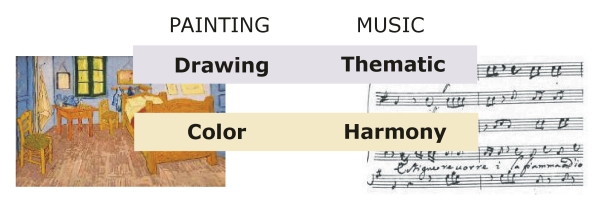Designing Music was originated by a little envy feeling towards plastic artists. They are able to outline, in few minutes, a graphical idea. If it exists clearly in their head, they can draw up its form, and even fill up it with color spots that reflect, more or less, how that idea is.
A composer, based on Western academic technique, can play the piano,
and try to do the same. Nevertheless, normally he/she will be more
limited than a painter. It is very probable that one of the main reasons
for that difference is just the opposed creative process that presents
both arts. If we admitted the following parallelism, used repeatedly
throughout the history of music:

it is easy to conclude that the creative process between them is
inverse. Whereas the painter always begins conceiving the formal design
and the drawing of his picture, the composers usually begin defining the
harmonic idea. There are
historical reasons
to explain this musical fact, which are not discussed here for brevity.
But, in any case, it is completely normal, even in the avant-garde
musical composition of the XXth century, and also now, that the
composers begin to work with the harmonic idea, to which they superpose
the thematic elaboration (an example of this is the
Twelve-tone
technique by
Schoenberg).
Designing Music Principles
![]()
Designing Music is a music creation methodology developed from 2004. It
consists of reversing the usual implicit process of musical creation,
radically postponing the application of harmonic color until all formal and
thematic structure of the piece has been produced. It relies on the DM-D
software and pursues, ultimately, bring the creative process of music to the
visual arts. Music Designing principles are:
- 1 - Designing not harmonized thematic-formal constructions,
quickly and easily, but without sacrificing complexity.
- 2 - Coloring harmonically those thematic-formal constructions
previously made.
- 3 - Being rigorous in order. It means: to absolutely postpone harmonization, if any, to the thematic-formal development.

Designing Music, therefore, is not only to use a software. It is an aesthetic attitude that implies to submit completely the harmonic factor to the formal-thematic one, reversing in a very premeditated way the common creative process in Western music. It can be used in the conception of a complete work, or it is possible to be applied only to fragments. So far, the result is a very different approach to the creative act. With an ultimate goal: also explore the possibility of a different way of musical expression.